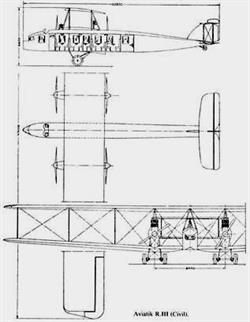The firm also made a large contribution to the R-plane programme as the most important licence manufacturer of Staaken R-planes. The initial order was for three Staaken R.VI machines numbered R.33/16 to R.35/16, the first of which was delivered in September 1917. Unofficially this series was known as the Aviatik R.I in company literature disseminated by Aviatik after the war. There is neither record nor reason to substantiate that the R.I designation was ever officially sanctioned. The first series was followed by a second batch of three Staaken R.VI machines numbered R.52/17 to R.54/17. These aircraft (known internally as Aviatik R.II) were modified to some extent by Aviatik, and in at least one instance the stepped, glassed-in cockpit was eliminated and replaced by a front-gun position and open cockpit raised flush with the upper longerons. The first aircraft (R.52) was initially powered by four 300 h.p. Basse & Selve BuS.IVa engines. These gave trouble during ground tests conducted on 7 May 1918, and were replaced by the more reliable, but less powerful, 245 h.p. Maybach Mb.IVa engines. The acceptance flight took place on 5 June, and Idflieg promised official acceptance on 28 June, provided that various defects were remedied. However, such was the demand for aircraft that the R.52 left for Rfa 500 at Morville on 20 June, stopping en route at Hannover due to poor weather conditions. The second machine, R.53, was delivered in July 1918, and was assigned to Rea Cologne as a trainer. The completion of the last Aviatik-built Staaken R.VI was delayed until October pending a decision whether or not to install a fifth Maybach in the nose. The final series built by Aviatik under licence was the Staaken R.XVI, R.49/17 to R.51/17 (known internally as Aviatik R.III), of which only the R.49 was delivered prior to the war's close.
In early 1919 Aviatik had the three-quarters completed R.50 and R.51 on its hands, and it received permission to complete these as commercial transports, but only the R.50 was finished
In hopes of entering the commercial passenger and air-mail aircraft business, Aviatik publicized the Aviatik R.III Civil Transport. The R.III received full coverage in the aeronautical Press, and beautifully retouched photographs gave the impression that the machine was actually built. However, the civil adaptation did not advance farther than the design stage. The fuselage was redesigned to accommodate eighteen passengers in seats placed back-to-back. A small open cupola was situated in the nose, followed by an enclosed observation cabin. The pilots were located in an open cockpit well ahead of the wings. The four tandem, geared 250 h.p. Benz engines were mounted on streamlined pylons above the lower wing. These pylons carried enough fuel for 7 hours maximum duration, and the engines were serviceable in flight. The wing area was increased by keeping the chord constant throughout the span. The crew consisted of an aircraft captain, two pilots, two engineers and a steward.
Engineers von Platen and Rau, both of whom had earlier been closely associated with the SSW R-plane programme (Rau as a member of Idflieg), later joined Aviatik to work on licence machines and advanced projects such as the R.III.

| Type |
Passenger and post carrying aircraft ( 1 captain, 2 pilots, 2 engineers, 1 steward + 18 passengers with luggage) |
| Engine |
4 Benz |
| Dimensions |
Length 22,5 m, height 6,5 m, span 43,5 m |
| Weights |
Empty 9000 kg, fuel and crew 1800 kg, payload 1800 kg |
| Performance |
Max. speed 125 km/h at 2500 m, climb to 3500 m 100 min., service ceiling 4000 m, endurance 7 h, range 875 km |
| Type |
Werk.Nr |
Registration |
History |
| R50 |
|
|
|
|
|
|
|

